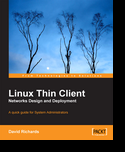
A few years ago I was asked to write a book and some of you have purchased it. Obviously one hopes that a book always meets the expectations of the reader, but there have been some negative reviews. Some of the goals while it was being written were not entirely matched to what people thought they were buying. Let me explain, and tell everyone what is in the book:
Obsolete Technology: When I was changing cubicles a few weeks ago all of the contents had to be packed and moved. I was shocked at the high number of books that were completely obsolete. I had a RedHat 6 book from 1999 and on inspection you find that nearly every technology has completely changed in 10 years. I wanted to create something that had a longer shelf life. In the time since the book was published, HP has already released two new thin client models. Had the book dug deeply into the internals of the model available at that time, it would have been just another technical book sitting around. So I wanted to include some topics that never change.
People Issues: The book deals a great bit about *people*. We as techies sometimes don't like to think about them or talk to them :) , but they are the biggest issue that you have to overcome when you move to thin clients and even more so when you move to Linux. Yeah, it saves lots of money, for sure...but if your administrative people aren't on board any project such as this is doomed. The book also deals with the fact that IT staff will have greatly changed duties post migration. You no longer have lots of people running around keeping client devices running and focus moves to R&D and centralized support. Instead of maintaining, you are improving and that sometimes requires different types of people.
Pictures And Pictures: All of you would be surprised at the number of people that think Linux is "character" and "command line". Many people think that if you move your email to Linux that you have an xterm window open with pine or something. During the editing process they asked me about including the screen shots, and I felt strongly that we needed to SHOW people applications like Firefox, Evolution, OpenOffice and Realplayer running graphically and similarly to how they look and work on Microsoft Windows. People also have this impression that if you have to get to Microsoft Windows applications from the Linux desktop that you have to log out in some manner and then connect to the various software packages. I felt it important to show that everything runs in a consolidated desktop, Windows and Linux apps right fine side by side.
Unique Site Requirements: Every deployment will be completely different, so it would be impossible to give exact instruction on how to setup and configure everything. So the book had to be about 'ideas'. I tried to describe exactly what was possible, and then leave it the reader to come up with a plan. I had no way of knowing the skills of the staff, the skills of the users, the money available and exactly what operating systems would be used. I also felt that more specific details would be available on my blog. I always try and blog about major milestones that we reach and hope that it's helpful.
There are good days and bad days on any computer system, but we have inched our way up to about 700 thin client workstations and things are still lightning fast. This design works, is stable and saves a lot of money.
3 comments:
You rock man, wish I had your job. Your next task, should you choose to accept it, is to integrate smart cards + pin for login and then single sign on for password storage.
I thought about doing this as a poor man's VDI. For the past couple of years I've been using LTSP to boot a few thin clients into rdesktop (on X11) connected to an XP VM. The downside is it's very specific to the thin client and user (in lts.conf). So that MAC is always going to RDP to one IP.
I thought about having the LTSP box on active directory, the thin client would let them log in to Gnome, and there would be an auto exec program to RDP to a certain VM -- that fixes the so and so sits down at any desk, logs in as them and boom they see their own VM, but isn't perfect. Ideally it'd work like Sun's sun ray product. Slide in a $2 smart card badge w/ their photo that HR issued, they type a PIN, and then they're resuming a session they already had - windows or linux.
Sorry to suck you back into the Windows world - I'm still stuck in it (hence wanting to be in your shoes lol!)
@anonymous: Yeah I don't tinker in the Windows world all that often. But we runs Windows Servers here instead of VMing XP as much as possible. The only time that XP is used is when we have crappy apps that are hard coded in some manner to require their own IP or they write files into areas that crap out when run multi-user. Windows Servers make it easier to float the sessions around. Our network is kind of the reverse, Linux is the authentication host and then Windows gets permission from there.
Commenting on an old post here...
I have wondered for years now about what kind of setup you were running, how it was laid out, etc. I had no idea that you had written about about the subject. That you intentionally made it not another technology book is great. It's going on the Amazon Wishlist right now!
Post a Comment